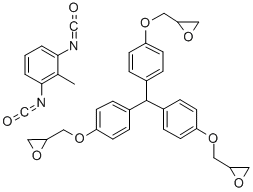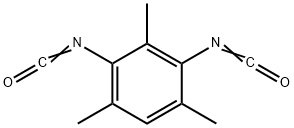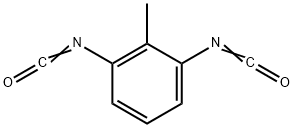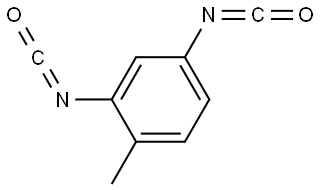1,3-PHENYLENE DIISOCYANATE
- CAS NO.:123-61-5
- Empirical Formula: C8H4N2O2
- Molecular Weight: 160.13
- MDL number: MFCD00002018
- EINECS: 204-637-7
- SAFETY DATA SHEET (SDS)
- Update Date: 2024-12-18 14:08:57

What is 1,3-PHENYLENE DIISOCYANATE?
Chemical properties
White to off-white fused solid
The Uses of 1,3-PHENYLENE DIISOCYANATE
1,??3-??Phenylene Diisocyanate is a reagent used in the synthesis of polyurethane materials and other thermoplastics.Environmental toxin on US EPA Toxic Release Inventory list (TRI) list.
Reactivity Profile
Isocyanates and thioisocyanates, such as 1,3-PHENYLENE DIISOCYANATE, are incompatible with many classes of compounds, reacting exothermically to release toxic gases. Reactions with amines, aldehydes, alcohols, alkali metals, ketones, mercaptans, strong oxidizers, hydrides, phenols, and peroxides can cause vigorous releases of heat. Acids and bases initiate polymerization reactions in these materials. Some isocyanates react with water to form amines and liberate carbon dioxide. Base-catalysed reactions of isocyanates with alcohols should be carried out in inert solvents. Such reactions in the absence of solvents often occur with explosive violence, [Wischmeyer(1969)].
Safety Profile
A sensitizer at very low concentrations. Deadly poison by intravenous route. When heated to decomposition it emits toxic fumes of NOx and CN-. See also ESTERS.
Properties of 1,3-PHENYLENE DIISOCYANATE
| Melting point: | 49-51 °C(lit.) |
| Boiling point: | 121 °C25 mm Hg(lit.) |
| Density | 1.3848 (rough estimate) |
| refractive index | 1.4900 (estimate) |
| Flash point: | >230 °F |
| storage temp. | 2-8°C |
| form | powder to lump |
| color | Crystals |
| Water Solubility | Soluble in hot benzene. Hydrolyzes in water. |
| Sensitive | Moisture Sensitive |
| BRN | 776957 |
| CAS DataBase Reference | 123-61-5(CAS DataBase Reference) |
| EPA Substance Registry System | 1,3-Phenylene diisocyanate (123-61-5) |
Safety information for 1,3-PHENYLENE DIISOCYANATE
| Signal word | Danger |
| Pictogram(s) |
 Exclamation Mark Irritant GHS07  Health Hazard GHS08 |
| GHS Hazard Statements |
H315:Skin corrosion/irritation H317:Sensitisation, Skin H319:Serious eye damage/eye irritation H334:Sensitisation, respiratory H335:Specific target organ toxicity, single exposure;Respiratory tract irritation |
| Precautionary Statement Codes |
P261:Avoid breathing dust/fume/gas/mist/vapours/spray. P264:Wash hands thoroughly after handling. P264:Wash skin thouroughly after handling. P280:Wear protective gloves/protective clothing/eye protection/face protection. P301+P312:IF SWALLOWED: call a POISON CENTER or doctor/physician IF you feel unwell. P305+P351+P338:IF IN EYES: Rinse cautiously with water for several minutes. Remove contact lenses, if present and easy to do. Continuerinsing. |
Computed Descriptors for 1,3-PHENYLENE DIISOCYANATE
New Products
Tert-butyl bis(2-chloroethyl)carbamate (S)-3-Aminobutanenitrile hydrochloride N-Boc-D-alaninol N-BOC-D/L-ALANINOL N-octanoyl benzotriazole 3,4-Dibenzyloxybenzaldehyde 4-Hydrazinobenzoic acid Electrolytic Iron Powder 1,1’-CARBONYLDIIMIDAZOLE R-2-BENZYLOXY PROPIONIC ACID 4-HYDROXY BENZYL ALCOHOL 1,1’-CARBONYLDI (1,2-4 TRIAZOLE) S-2-CHLORO PROPIONIC ACID (2-Hydroxyphenyl)acetonitrile 4-Bromopyrazole 5-BROMO-2CYANO PYRIDINE 5,6-Dimethoxyindanone 5-broMo-2-chloro-N-cyclopentylpyriMidin-4-aMine 3-(2,4-Dimethoxybenzyl)dihydropyrimidine-2,4(1H,3H)-dione 6-Bromo-3-iodo-1-methyl-1H-indazole N-Boc-L-proline methyl ester 2-(BOC-Amino)4-picoline 1-(4-Methylphenylsulfonyl)-1H-1,2,3-benzotriazole 1-(2-Chlorobenzyl)-4-nitro-1H-pyrazoleRelated products of tetrahydrofuran








You may like
-
 1,3-Phenylene Diisocyanate CAS 123-61-5View Details
1,3-Phenylene Diisocyanate CAS 123-61-5View Details
123-61-5 -
 1,3-Phenylene diisocyanate CAS 123-61-5View Details
1,3-Phenylene diisocyanate CAS 123-61-5View Details
123-61-5 -
 Ste-Glu-AEEA-AEEA-OSUView Details
Ste-Glu-AEEA-AEEA-OSUView Details
1169630-40-3 -
 1446013-08-6 Fmoc-His-Aib-OH TFA 98%View Details
1446013-08-6 Fmoc-His-Aib-OH TFA 98%View Details
1446013-08-6 -
 127464-43-1 99%View Details
127464-43-1 99%View Details
127464-43-1 -
 Chloro Uracil 99%View Details
Chloro Uracil 99%View Details
1820-81-1 -
 2-ETHYLPYRIDINE 100-71-0 99%View Details
2-ETHYLPYRIDINE 100-71-0 99%View Details
100-71-0 -
 13162-05-5 99%View Details
13162-05-5 99%View Details
13162-05-5